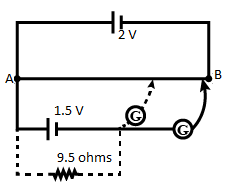
The figure shows a $2.0\,V$ potentiometer used for the determination of internal resistance of a $1.5\,V$ cell. The balance point of the cell in the open circuit is $76.3\,cm$. When a resistor of $9.5\,\Omega $ is used in the external circuit of the cell, the balance point shifts to $64.8\,cm$ length of the potentiometer. The internal resistance of the cell is:

(A) $1.63\,\Omega $
(B) $1.66\,\Omega $
(C) $1.69\,\Omega $
(D) $1.72\,\Omega $
Answer
220.2k+ views
Hint The internal resistance of the potentiometer can be determined by using the internal resistance formula of the potentiometer. The internal resistance is depending on the resistance of the resistor, distance of the two balance points in the potentiometer.
Useful formula
The expression for the internal resistance of a cell in potentiometer is given by,
$r = R\left( {\dfrac{{{l_1}}}{{{l_2}}} - 1} \right)$
Where, $r$ is the internal resistance of the cell in the potentiometer, $R$ is the resistance of the resistor, ${l_1}$ is the distance of the initial balance point and ${l_2}$ is the distance of the final balance point.
Complete step by step solution
Given that,
The voltage of the potentiometer is, $V = 2.0\,V$,
The balance point of the cell in open circuit is, ${l_1} = 76.3\,cm$,
The balance point shifts to the length of the potentiometer is, ${l_2} = 64.8\,cm$.
The resistance of the resistor is, $R = 9.5\,\Omega $
Now,
The expression for the internal resistance of a cell in potentiometer is given by,
$r = R\left( {\dfrac{{{l_1}}}{{{l_2}}} - 1} \right)\,..................\left( 1 \right)$
By substituting the resistance of the resistor, the length of the balance point of the cell in open circuit and the balance point shifts to length of the potentiometer in the above equation (1), then the above equation (1) is written as,
$r = 9.5\left( {\dfrac{{76.3}}{{64.8}} - 1} \right)$
By dividing the terms in the above equation, then
$r = 9.5\left( {1.178 - 1} \right)$
By subtracting the terms in the above equation, then
$r = 9.5\left( {0.178} \right)$
By multiplying the terms in the above equation, then
$r = 1.69\,\Omega $
Hence, the option (C) is the correct answer.
Note The internal resistance of a cell is directly proportional to the resistance of the resistor and the ratio of the length of the balancing point. If the resistance of the resistor is increasing, the internal resistance of the cell is also increasing.
Useful formula
The expression for the internal resistance of a cell in potentiometer is given by,
$r = R\left( {\dfrac{{{l_1}}}{{{l_2}}} - 1} \right)$
Where, $r$ is the internal resistance of the cell in the potentiometer, $R$ is the resistance of the resistor, ${l_1}$ is the distance of the initial balance point and ${l_2}$ is the distance of the final balance point.
Complete step by step solution
Given that,
The voltage of the potentiometer is, $V = 2.0\,V$,
The balance point of the cell in open circuit is, ${l_1} = 76.3\,cm$,
The balance point shifts to the length of the potentiometer is, ${l_2} = 64.8\,cm$.
The resistance of the resistor is, $R = 9.5\,\Omega $
Now,
The expression for the internal resistance of a cell in potentiometer is given by,
$r = R\left( {\dfrac{{{l_1}}}{{{l_2}}} - 1} \right)\,..................\left( 1 \right)$
By substituting the resistance of the resistor, the length of the balance point of the cell in open circuit and the balance point shifts to length of the potentiometer in the above equation (1), then the above equation (1) is written as,
$r = 9.5\left( {\dfrac{{76.3}}{{64.8}} - 1} \right)$
By dividing the terms in the above equation, then
$r = 9.5\left( {1.178 - 1} \right)$
By subtracting the terms in the above equation, then
$r = 9.5\left( {0.178} \right)$
By multiplying the terms in the above equation, then
$r = 1.69\,\Omega $
Hence, the option (C) is the correct answer.
Note The internal resistance of a cell is directly proportional to the resistance of the resistor and the ratio of the length of the balancing point. If the resistance of the resistor is increasing, the internal resistance of the cell is also increasing.
Recently Updated Pages
Electricity and Magnetism Explained: Key Concepts & Applications

JEE Energetics Important Concepts and Tips for Exam Preparation

JEE Isolation, Preparation and Properties of Non-metals Important Concepts and Tips for Exam Preparation

JEE Main 2021 July 25 Shift 1 Question Paper with Answer Key

JEE Main 2021 July 22 Shift 2 Question Paper with Answer Key

States of Matter Chapter For JEE Main Chemistry

Trending doubts
JEE Main 2026: Application Form Open, Exam Dates, Syllabus, Eligibility & Question Papers

Understanding Uniform Acceleration in Physics

Derivation of Equation of Trajectory Explained for Students

Hybridisation in Chemistry – Concept, Types & Applications

Understanding the Angle of Deviation in a Prism

How to Convert a Galvanometer into an Ammeter or Voltmeter

Other Pages
JEE Advanced Marks vs Ranks 2025: Understanding Category-wise Qualifying Marks and Previous Year Cut-offs

Dual Nature of Radiation and Matter Class 12 Physics Chapter 11 CBSE Notes - 2025-26

Understanding Centrifugal Force in Physics

JEE Main Marking Scheme 2026- Paper-Wise Marks Distribution and Negative Marking Details

Degree of Dissociation: Meaning, Formula, Calculation & Uses

Ideal and Non-Ideal Solutions Explained for Class 12 Chemistry




